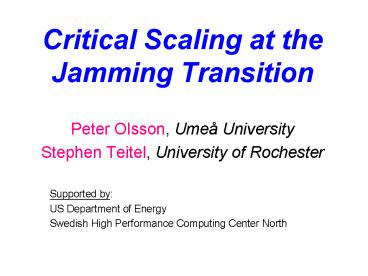Critical Scaling at the Jamming Transition - PowerPoint PPT Presentation
Title:
Critical Scaling at the Jamming Transition
Description:
Critical Scaling at the Jamming Transition Peter Olsson, Ume University Stephen Teitel, University of Rochester Supported by: US Department of Energy – PowerPoint PPT presentation
Number of Views:127
Avg rating:3.0/5.0
Title: Critical Scaling at the Jamming Transition
1
Critical Scaling at the Jamming Transition
- Peter Olsson, Umeå University
- Stephen Teitel, University of Rochester
- Supported by
- US Department of Energy
- Swedish High Performance Computing Center North
2
outline
introduction - jamming phase diagram our
model for a granular material simulations in 2D
at T 0 scaling collapse for shear viscosity
correlation length critical exponents
conclusions
3
flowing ? rigid but disordered
granular materials large grains ? T 0
upon increasing the volume density of particles
above a critical value the sudden appearance of a
finite shear stiffness signals a transition from
a flowing state to a rigid but disordered state -
this is the jamming transition point J
sheared foams polydisperse densely packed
gas bubbles
upon decreasing the applied shear stress below a
critical yield stress, the foam ceases to flow
and behaves like an elastic solid
structural glass
upon decreasing the temperature, the viscosity of
a liquid grows rapidly and the liquid freezes
into a disordered rigid solid
animations from Leiden granular group website
4
conjecture by Liu and Nagel (Nature 1998)
jamming point J is a special critical point in
a larger 3D phase diagram with the three axes ?
? volume density T ? temperature ? ? applied
shear stress (nonequilibrium
axis)
understanding T 0 jamming at point J in
granular materials may have implications for
understanding the structural glass transition at
finite T
here we consider the ?????? plane at T 0
5
shear viscosity of a flowing granular material
6
model granular material
(OHern, Silbert, Liu, Nagel, PRE 2003)
bidisperse mixture of soft disks in two
dimensions at T 0 equal numbers of disks with
diameters d1 1, d2 1.4
interaction V(r) (frictionless)
7
dynamics
8
simulation parameters
Lx Ly N 1024 for ? lt 0.844 N 2048 for ?
0.844 ?t 1/N, integrate with Heuns
method ?(ttotal) 10, ranging from 1 to 200
depending on N and ?
finite size effects negligible (cant get too
close to ?c)
animation at ? 0.830 ? 0.838 ? ?c ? 0.8415
? 10-5
9
results for small ? 10-5 (represents ? ? 0
limit, point J)
as N increases, ?-1(?) vanishes continuously at
?c ? 0.8415
smaller systems jam below ?c
10
results for finite shear stress ?
11
scaling about point J for finite shear stress ?
scaling hypothesis (2nd order phase
transitions) at a 2nd order critical point, a
diverging correlation length ?? determines all
critical behavior quantities that vanish at the
critical point all scale as some power of
??? rescaling the correlation length, ? ? b?,
corresponds to rescaling
?????b??????????????????b???????????????????b????
12
scaling law
?????????????b????????b???????b?????
choose length rescaling factor b ? ????
13
possibilities
???? 0 stress ? is irrelevant variable ? jamming
at finite ? in same universality class
as point J (like adding a small
magnetic field to an antiferromagnet)
???? 0 stress ? is relevant variable ? jamming at
finite ? in different universality
class from point J
i) f?(z) vanishes only at z ??0
finite ? destroys the jamming transition (like
adding a small magnetic field to a ferromagnet)
- ii) f(z) ? z - z0?' vanishes as z ??z0
from above
??1 vanishes as ????????????'
(like adding small anisotropy field at a
spin-flop bicritical point)
14
scaling collapse of viscosity ?
stress ? is a relevant variable
point J is a true 2nd order critical point
unclear if jamming remains at finite ?
15
correlation length
regions separated by ? are anti-correlated
motion is by rotation of regions of size ?
16
scaling collapse of correlation length ?
? diverges at point J
17
phase diagram in ??? plane
18
critical exponents
???????????????????????? ?????????????????? ?
??? ?????????????????????????? ???????????????????
????? ??????????????????????? ??????
if scaling is isotropic, then expect ? ? d?x/dy
is dimensionless then ?d?? dimensionless ?
??????d ? ??????d???? ???????d??dt)/??????z?d
??(z?d) ? z ???? d 4.83
where z is dynamic exponent
19
conclusions
point J is a true 2nd order critical point
correlation length diverges at point J critical
scaling extends to non-equilibrium driven
steady states at finite shear stress ? ????? in
agreement with proposal by Liu and Nagel shear
stress ? is a relevant variable that
changes the critical behavior at point J
jamming transition at finite ? remains to be
clarified finite temperature?































